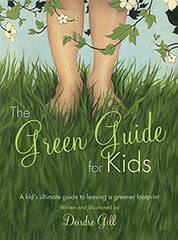BUY ENERGY-SAVING "LED" HOLIDAY LIGHTS
 Now you can decorate your house with LED lights that use 90 percent less energy than conventional holiday lights, and can save your family up to $50 on your energy bills during the holiday season! LED lights are available at many major retailers, including Target, CostCo, and Ace Hardware.
Now you can decorate your house with LED lights that use 90 percent less energy than conventional holiday lights, and can save your family up to $50 on your energy bills during the holiday season! LED lights are available at many major retailers, including Target, CostCo, and Ace Hardware.GET A PESTICIDE-FREE TREE
 Demand is on the rise for Christmas trees that are not covered in chemicals; some growers use 40 different pesticides, as well as chemical colorants. The good news is that there are now a number of tree-farms that sell pesticide-free trees, so ask your local Christmas tree seller, or search for an organic tree farm near you.
Demand is on the rise for Christmas trees that are not covered in chemicals; some growers use 40 different pesticides, as well as chemical colorants. The good news is that there are now a number of tree-farms that sell pesticide-free trees, so ask your local Christmas tree seller, or search for an organic tree farm near you.DO A "COOL HOME" TOUR WITH OUR ENERGY-SAVING CHECKLIST
 Take a pledge this New Years' to reduce your home energy use by buying energy-efficient light bulbs. Installing only 6 compact fluorescent light bulbs will save the average American family $60 per year. You can also use our handy "Cool Homes" checklist to see what easy things you can do in your home to save energy. If there's a fire in your fireplace this Christmas, turn down that thermostat! Lowering the temperature even five degrees can take 10% off your energy bill.
Take a pledge this New Years' to reduce your home energy use by buying energy-efficient light bulbs. Installing only 6 compact fluorescent light bulbs will save the average American family $60 per year. You can also use our handy "Cool Homes" checklist to see what easy things you can do in your home to save energy. If there's a fire in your fireplace this Christmas, turn down that thermostat! Lowering the temperature even five degrees can take 10% off your energy bill.ADD ORGANIC & LOCAL FOODS TO YOUR HOLIDAY FEAST
 Support local family farmers who grow sustainable meat and produce. Not only does it taste better, you'll be doing your part for the planet too. Looking for an organic turkey or ham for Christmas dinner? Find out where to get local green products in your neighborhood.
Support local family farmers who grow sustainable meat and produce. Not only does it taste better, you'll be doing your part for the planet too. Looking for an organic turkey or ham for Christmas dinner? Find out where to get local green products in your neighborhood.










4 comments:
How To Reduce Your Heating Bills This Winter / Energy Conservation Begins at Home
Imagine leaving a window open all winter long -- the heat loss, cold drafts and wasted energy! If your home has a folding attic stair, a whole house fan or AC Return, a fireplace or a clothes dryer, that may be just what is occurring in your home every day.
These often overlooked sources of heat loss and air leakage can cause heat to pour out and the cold outside air to rush in -- costing you higher heating bills.
Air leaks are the largest source of heating and cooling loss in the home. Air leaks occur through the small cracks around doors, windows, pipes, etc. Most homeowners are well aware of the benefits caulk and weatherstripping provide to minimize heat loss and cold drafts.
But what can you do about the four largest “holes” in your home -- the folding attic stair, the whole house fan or AC return, the fireplace, and the clothes dryer? Here are some tips and techniques that can easily, quickly and inexpensively seal and insulate these holes.
Attic Stairs
When attic stairs are installed, a large hole (approximately 10 square feet) is created in your ceiling. The ceiling and insulation that were there have to be removed, leaving only a thin, unsealed, sheet of plywood.
Your attic space is ventilated directly to the outdoors. In the winter, the attic space can be very cold, and in the summer it can be very hot. And what is separating your conditioned house from your unconditioned attic? That thin sheet of plywood.
Often a gap can be observed around the perimeter of the door. Try this yourself: at night, turn on the attic light and shut the attic stairway door -- do you see any light coming through? These are gaps add up to a large opening where your heated/cooled air leaks out 24 hours a day. This is like leaving a window open all year round.
An easy, low-cost solution to this problem is to add an attic stair cover. An attic stair cover provides an air seal, reducing the air leaks. Add the desired amount of insulation over the cover to restore the insulation removed from the ceiling.
Whole House Fans and AC Returns
Much like attic stairs above, when whole house fans are installed, a large hole (up to 16 square feet or larger) is created in your ceiling. The ceiling and insulation that were there have to be removed, leaving only leaky ceiling shutter between the house and the outdoors.
An easy, low-cost solution to this problem is to add a whole house fan cover. Installed from the attic side, the whole house fan cover is invisible. Cover the fan to reduce heating and air-conditioning loss, remove it when use of the fan is desired.
If attic access is inconvenient, or for AC returns, a ceiling shutter cover is another option for reducing heat loss through the ceiling shutter and AC return. Made from R-8, textured, thin, white flexible insulation, and installed from the house side over the ceiling shutter with Velcro, a whole house fan shutter cover is easily installed and removed.
Fireplaces
Sixty-five percent, or approximately 100 million homes, in North America are constructed with wood or gas burning fireplaces. Unfortunately there are negative side effects that the fireplace brings to a home especially during the winter home-heating season. Fireplaces are energy losers.
Researchers have studied this to determine the amount of heat loss through a fireplace, and the results are amazing. One research study showed that an open damper on an unused fireplace in a well-insulated house can raise overall heating-energy consumption by 30 percent.
A recent study showed that for many consumers, their heating bills may be more than $500 higher per winter due to the air leakage and wasted energy caused by fireplaces.
Why does a home with a fireplace have higher heating bills? Hot air rises. Your heated air leaks out any exit it can find, and when warm heated air is drawn out of your home, cold outside air is drawn in to make up for it. The fireplace is like a giant straw sucking the heated air from your house.
An easy, low-cost solution to this problem is to add a fireplace draftstopper. Available from Battic Door, a company known for their energy conservation products, a fireplace draftstopper is an inflatable pillow that seals the damper, eliminating any air leaks. The pillow is removed whenever the fireplace is used, then reinserted after.
Clothes Dryer Exhaust Ducts
In many homes, the room with the clothes dryer is the coldest room in the house. Your clothes dryer is connected to an exhaust duct that is open to the outdoors. In the winter, cold air leaks in through the duct, through your dryer and into your house.
Dryer vents use a sheet-metal flapper to try to reduce this air leakage. This is very primitive technology that does not provide a positive seal to stop the air leakage. Compounding the problem is that over time, lint clogs the flapper valve causing it to stay open.
An easy, low-cost solution to this problem is to add a dryer vent seal. This will reduce unwanted air infiltration, and keep out pests, bees and rodents as well. The vent will remain closed unless the dryer is in use. When the dryer is in use, a floating shuttle rises to allow warm air, lint and moisture to escape.
If your home has a folding attic stair, a whole house fan, an AC return, a fireplace, and/or a clothes dryer, you can easily, quickly and inexpensively seal and insulate these holes.
Mark D. Tyrol is a Professional Engineer specializing in cause and origin of construction defects. He developed several residential energy conservation products including an attic stair cover and a fireplace draftstopper. To learn more visit www.batticdoor.com
This year I bought a bonsai christmas tree. I didn't do it for the good of the environment specifically but because I have only a small apartment and I happen to like bonsai.
It should work out pretty nicely though. My plan is to plant the tree outdoors once the Christmas period is over and let it return to its natural environment.
By the way, fantastic post, Deidre. Live trees can be green, but it's much more complex than just "live is good ~ yay". Thank you for concisely explaining that. :) You rock, and happy green holidays to you!
Post a Comment